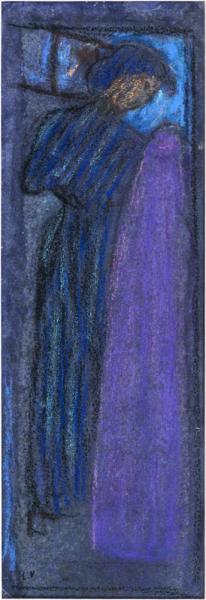La couturière à l'étoffe mauve, effet de nuit, 1890
Pastel and charcoal on paper, artist studio stamp lower left.
26.50 x 9 cm
Provenance :
Artist's studio
Thadée Natanson's collection, Paris
Purchased again by Vuillard in 1908
Misia Sert, 1910
Misia Sert' succession
Certificate of inclusion in the supplement of the catalogue raisonné of the paintings and pastel works of Edouard Vuillard issued by Comité Vuillard and dated 6 September 2019
This work by Edouard Vuillard belonged to the mythical couple formed by Misia and Thadée Natanson. The couple separated, Misia did not get this work at the time of the division, which distressed her. Its creator Edouard Vuillard bought the work from Natanson to offer it to his friend, an eminently symbolic gesture on the part of the one who was thought to be madly in love with Misia.
"Misia is a monument brought from a distant country to Paris, like the obelisk, and placed in the axis of French taste as the needle of Luxor is in the axis of the Champs-Élysées."
Paul Morand's formula is as famous as it is inescapable as soon as one wishes to introduce Misia to those of our time who would not know her. Better still, it is right. Marie Godebska, Misia Natanson, Mrs. Edwards and Misia Sert... are all versions of the patron muse, the adored admirer of artists, whether they are musicians, writers, dancers or painters of course. Madame Verdurinska, as Coco Chanel sometimes called her, not without a touch of perfidy towards her friend. Would it be enough to say that she served as a model for Proust for one, and even several characters in La Recherche, to give Misia the scope of her empire on the French cultural and artistic life of the Belle époque and beyond?
Born in 1872 to a father of Polish origin and a Belgian mother, her ancestors seem to determine her passions: an artist father, a sculptor, son and grandson of a writer, and a mother, whom she would not know, but who was herself the offspring of a brilliant cellist. The young Marie was naturally drawn to music. A virtuoso pianist who had studied with Gabriel Fauré, she was a little too emancipated for her environment and her time. At a very young age, she saw herself living alone, freed from the social shackles that oppressed her, and gave piano lessons to a few students. She soon married Thadée Natanson, who, with his brother, had founded the Revue blanche, a literary and artistic periodical that covered the main ideological debates of the time and to which the leading intellectuals and artists of the late 19th century contributed: Mallarmé, Apollinaire, Fénéon, Mirbeau, Gide, Jarry, Lugné-Poe, Toulouse-Lautrec, Bonnard, Vuillard, Vallotton... All or almost all of them became friends of Misia, succumbed to her charm, dedicated poems to her, took her as a model for their paintings. Vuillard in particular, is sensitive more than the others to the aura of Misia. It is said that he was deeply in love with her. Since he was unable to realize this passion, he became the faithful friend and confidant of the adored woman.
Renoir also painted Misia with her hair up, revealing her generous bosom under the wide collar of her dress. Bonnard, Vallotton, Toulouse-Lautrec, each of them let themselves be seduced by the side of Misia that they liked the most, the muse having as much domestic sweetness in her as icy femininity, as well as a roguish spirit, this infinite complexity making her unique and irresistible in the eyes of artists. While she separated from Natanson, she moved away from the first group of artists she loved, the Revue Blanche, whose hours were numbered. Remarried in 1905 to the wealthy businessman and press magnate Edwards, she continued to support them, both financially and by carrying the esteem she held for them among the whole of Paris, of which she had become one of the undisputed queens.
Her young rival Lantelme having taken her second husband away from her with no hope of return, Misia once again separated meets the third man in her life, the painter José Maria Sert, a flamboyant Spaniard. Another artistic circle was formed around her, largely around the Ballets Russes, which brilliantly combined music, dance and painting in a spirit of modernity with a whiff of scandal. Thus, Diaghilev, Nijinsky, Stravinsky, Cocteau, Picasso and Satie to some extent... are Misia's new friends. And the talented Coco Chanel, who consoles Misia when Sert finally turns away from her but does not let her show a certain form of rivalry.
Misia, who died in 1950, leaves behind a fragmented image; that of a seductive, inspiring, bewitching muse, of an autocratic benefactress of the arts of her time, of a woman in love and wounded, by turns exquisite and imperious, fragile but independent, self-centered and generous. Each portrait of her reveals a facet of her. Yet her image is elusive, and not only because of the medium of paint, the brush giving her features dear to those who take her as a model. The photographs, the testimonies, only maintain the enigma of her attraction. We miss the sound of her voice, her subtle touch on the piano, her walk, the liveliness of her spirit and even her wake, finally, the essence of the things that died with them and that made her a unique and special being, capable of inspiring such strong feelings around us. In her legend, Misia embodies the impenetrable mystery of femininity, to whose shores one is constantly tempted to approach, irresistibly.
Giulia Pentcheff

